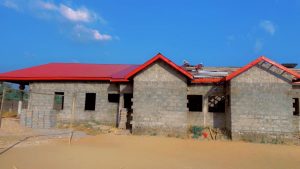A Journey of Hope and Dedication: Building a Clinic Amidst Adversity
Growing up in a large family of thirteen siblings, I was raised with the understanding that each of us had unique dreams and aspirations. My parents managed a modest life on our rice farm, while my mother supplemented our income through a small business selling clothes and vegetables.
Despite the economic challenges, I was fortunate enough to attend school and continue my education for two years of college. My hard work paid off when I won a scholarship to study medicine in the USSR. However, circumstances led me to immigrate to the USA before I could embark on this journey.
The timing of my move to the USA coincided tragically with the outbreak of a devastating civil war in my home country. The conflict left a trail of destruction, obliterating schools and medical facilities.
In the aftermath, when the civil war eventually subsided, my wife and I opened a school and hired teachers, teaching children in a church building at the Jui-way camp. We dedicated ourselves to supporting these children and their families as best as we could.
The personal losses I endured during this period deeply impacted me. My younger sister succumbed to septicemia and my older brother to pneumonia—both deaths attributed to the lack of medical facilities and affordable treatments. Their untimely deaths galvanized my resolve to build a hospital that could provide crucial medical care to those in need.
In 2004, I acquired a piece of land in Waterloo, approximately 50 miles from Freetown.
My vision began to take shape as we constructed a small school to educate local children and dug a well to supply clean water to the community. With financial support from friends and family, alongside the income from working two jobs, we managed to pay teachers and provide some nutritional support for the students.
Driven by my dream, I decided to establish a clinic to further assist the local population, many of whom lacked the resources to access the main hospital.
The hospital, as conceived, includes 16 private rooms, 2 classrooms, a laboratory, and a pharmacy. The classrooms are designed to train Nursing Assistants, teach about diseases, and provide education on disease prevention and infection control.
They will also serve for orientation and continuing education.
For the past six years, I have been working tirelessly, seven days a week, juggling two jobs to fund the project. The savings were initially used to fence the land and lay the foundation for the hospital.
Once the foundation was complete and the bricks were molded, I sought assistance from friends and family and continued to work relentlessly. I have also utilized a bartering system, offering workers tools, rice, clothes, and other essentials in exchange for their labor.
Additionally, I have been gathering medical equipment and supplies, shipping them in containers as they become available.
The construction has progressed significantly. The building, started two years ago, is now ready for roofing, with plans to complete this phase and install doors by December 2024.
Plastering of the walls is scheduled for February 2005, with the clinic anticipated to open and commence operations in March 2026.
To complete the clinic and ensure its successful operation, an additional $80,000 is required. This funding will cover the acquisition of laboratory equipment, an X-ray machine, refrigerators, generators or solar batteries, and analytical instruments.
We aim to enlist local doctors from Sierra Leone, as well as from the USA and India.
The pharmacy will be an integral part of the clinic, and we plan to support it through fundraising efforts. We will reach out to charity organizations such as Doctors Without Borders, as well as churches, mosques, temples, and any other groups willing to contribute.
This project represents not just a personal dream but a beacon of hope for a community in dire need of medical care and education.
Through collective effort and continued support, we are determined to turn this vision into a reality.
